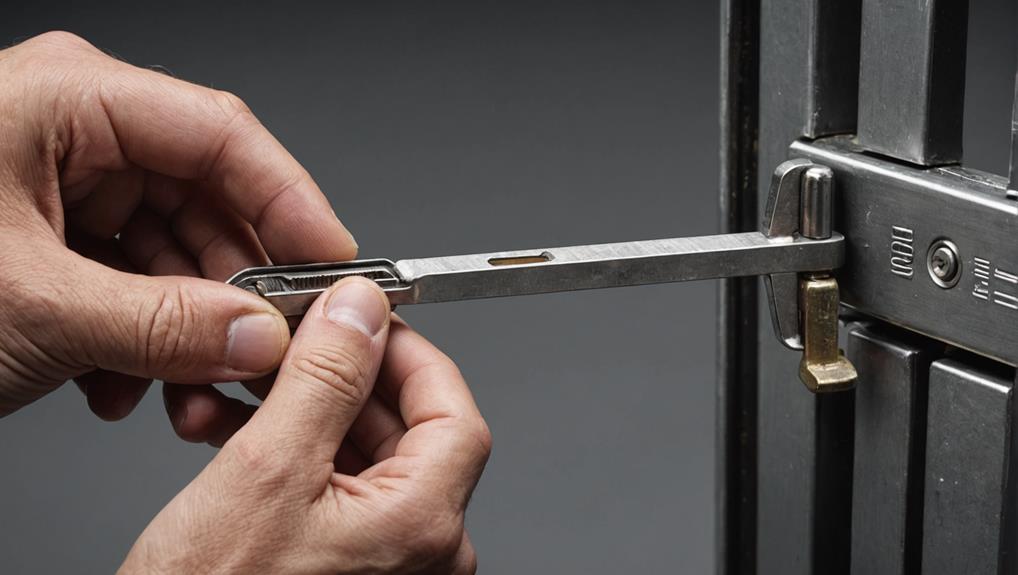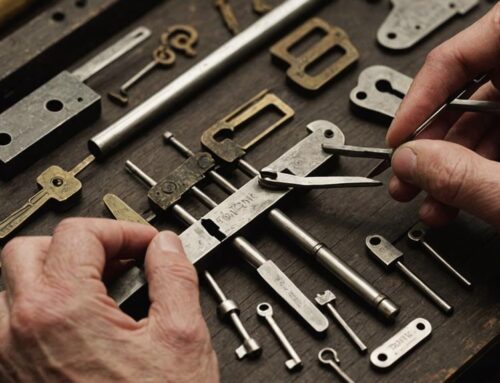To master non-destructive lock picking, understanding techniques like basic pin tumbler picking, raking, and using bump keys is key. Tools such as Lishi tools for sensitive entry and shimming for padlocks offer diverse methods. Bypassing wafer tumbler locks and exploiting master key systems add complexity. Decoding combination locks requires patience, decoding tools, and keen observation for success. Impressioning duplicates keys without damage. Discover in-depth insights into these techniques and tools to enhance your lock picking expertise in maneuvering various security mechanisms.
Key Takeaways
- Use specialized tools like rakes and tubular lock picks for non-destructive entry.
- Master tension control and pin manipulation techniques for successful lock picking.
- Understand lock components and feedback to align pins or wafers effectively.
- Employ bump keys responsibly on basic residential locks for non-destructive entry.
- Utilize decoding tools such as decoder wheels and light sources for combination locks.
Basic Pin Tumbler Lock Picking
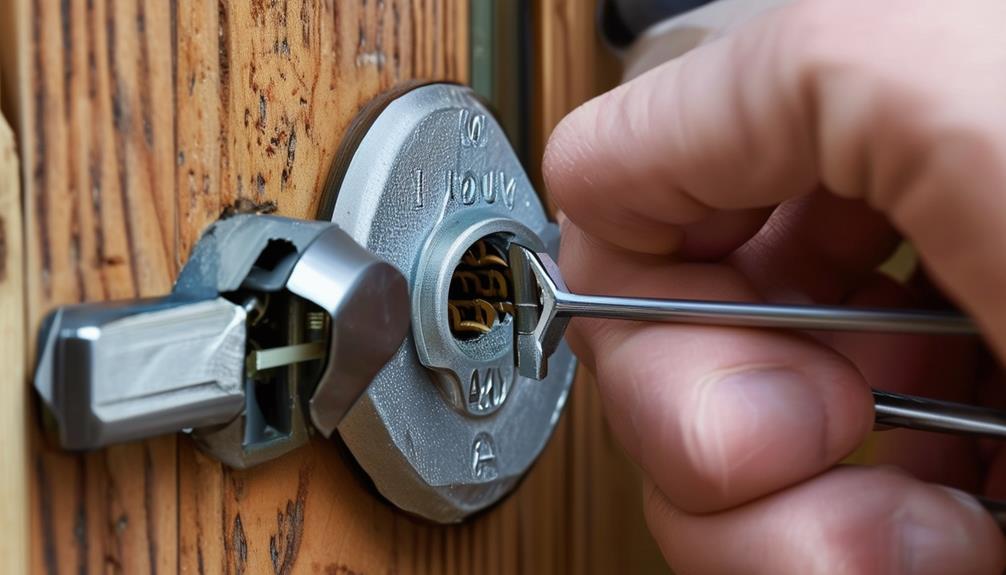
To begin your exploration of Basic Pin Tumbler Lock Picking, understanding the fundamental mechanics is vital. The pin tumbler lock is designed to provide a high level of security, making it a common target for those learning the art of non-destructive lock picking.
Inside a pin tumbler lock, there are driver pins and key pins. The driver pins sit above the shear line, preventing the plug from rotating. On the other hand, the key pins rest below the shear line and align with the cuts on the key.
To pick this type of lock, you use a tension wrench to apply slight turning pressure to the plug while using a pick to manipulate the pins. By gently lifting the pins to the correct height, you can create a gap at the shear line, allowing the plug to turn and the lock to open.
Mastering this technique requires patience, practice, and a good feel for the feedback the lock provides as you work through the pins. For more insights on essential picking techniques, practice is vital to developing your skills.
Bypassing Wafer Tumbler Locks
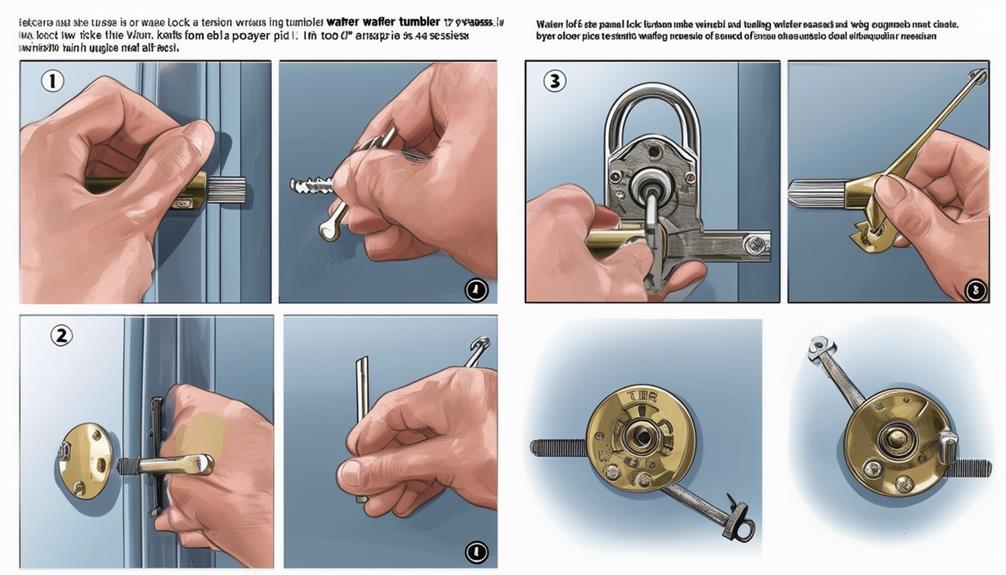
Understanding the mechanics of Wafer Tumbler Locks is essential to mastering the art of non-destructive lock bypassing. These locks use wafers instead of pins, making them vulnerable to different techniques.
To successfully bypass a wafer tumbler lock, consider the following:
- Wafer Configuration: Learn how the wafers are aligned within the lock to understand how they interact when a key is inserted. Familiarizing yourself with the specialized lock picks can also enhance your approach to different locks.
- Tension Control: Applying the right amount of tension is vital to allow the wafers to move freely without binding.
- Individual Wafer Manipulation: Focus on manipulating each wafer individually, ensuring they're set at the shear line correctly.
- Feedback Interpretation: Pay attention to the feedback the lock provides, such as subtle clicks or movements, to gauge progress accurately.
Raking Techniques for Lock Picking
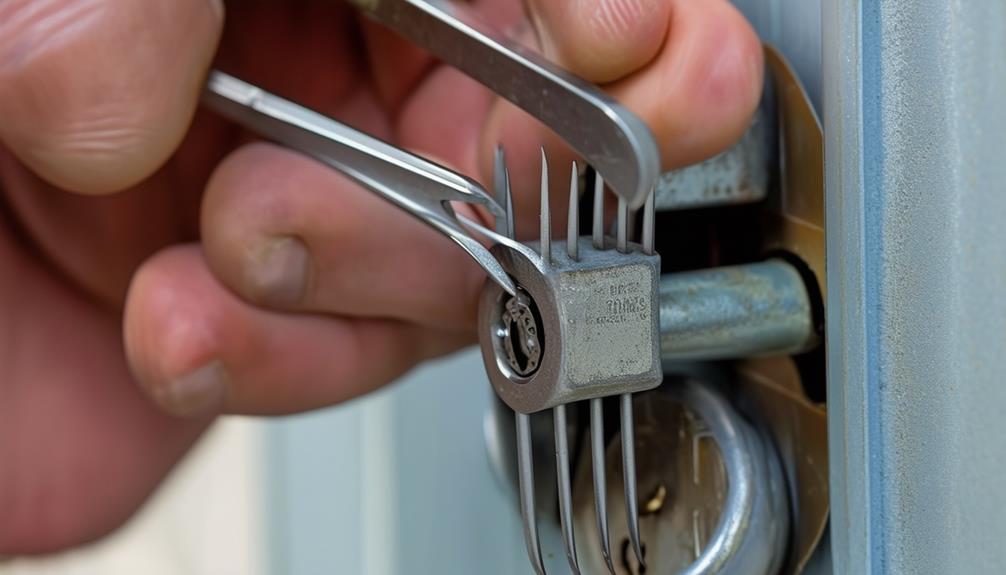
When it comes to lock picking, raking techniques offer a versatile approach for bypassing a variety of pin tumbler locks efficiently.
Raking involves using a specially designed tool, such as a rake or a diamond pick, to rapidly manipulate the pins inside the lock. The basic idea behind raking is to mimic the action of a key moving in and out of the lock to set the pins into place.
Understanding the fundamentals of lock picking is essential, as each lock presents unique challenges that can affect the success of your raking technique.
To use raking techniques effectively, insert the rake into the keyway and apply slight pressure to the tension wrench to create tension on the plug. Then, move the rake in and out of the keyway while applying varying degrees of pressure.
This motion helps to jostle the pins until they set, allowing the plug to rotate and the lock to open.
Raking techniques are popular among locksmiths and hobbyist lock pickers due to their speed and simplicity.
With practice and skill, raking can be a quick and effective method for gaining entry into many pin tumbler locks.
Using Lishi Tools for Non-Destructive Entry

Using Lishi Tools for Non-Destructive Entry
Raking techniques provide a solid foundation for understanding the principles of lock manipulation. When it comes to non-destructive entry methods, Lishi tools are highly effective and widely used by locksmiths for gaining access to various types of locks.
These tools are specifically designed to manipulate the internal components of the lock without causing any damage. Mastering these techniques is essential for enthusiasts looking to elevate their skills in lock picking, as outlined in advanced lock picking techniques.
Here are some key points to take into account when using Lishi tools:
- Precision is Key: Lishi tools require a steady hand and careful attention to detail to guarantee successful entry.
- Understanding Lock Mechanisms: Familiarize yourself with different lock types and how Lishi tools can be applied to each one.
- Practice Makes Perfect: Regular practice with Lishi tools will enhance your skill and proficiency in non-destructive lock picking.
- Professional Training: Contemplate undergoing training from experienced locksmiths to master the art of using Lishi tools effectively.
Decoding Combination Locks

Let's explore the intricate workings of combination lock mechanisms, the step-by-step process of decoding them, and the specialized tools used for this purpose.
Understanding the inner workings of these locks, including the various types and mechanisms of combination locks, and the systematic approach to decoding them is essential for successful entry.
The right tools and techniques can make decoding combination locks a precise and efficient process.
Combination Lock Mechanisms
To successfully decode combination locks, understanding the inner workings of the mechanism is vital. Combination locks rely on a specific sequence of numbers or symbols to open.
Here are some key points to help you grasp the basics of combination lock mechanisms:
- Mechanism Components: Combination locks consist of a dial, spindle, wheels, and a locking mechanism that interacts with the correct combination to release the lock.
- Number of Wheels: Typically, combination locks have multiple wheels, each representing one digit of the combination.
- Alignment Mark: The alignment mark on the dial indicates the current position of the wheels, allowing you to align them correctly for opening.
- Gate Mechanism: A gate mechanism inside the lock aligns when the correct combination is entered, releasing the shackle and allowing the lock to open.
Understanding these components and how they work together is vital for successfully decoding combination locks during safe lockpicking.
Decoding Process Steps
Having gained insight into the inner workings of combination locks in the previous section, the focus now shifts to the practical aspect of deciphering these mechanisms.
When attempting non-destructive entry into a combination lock, the decoding process involves a systematic approach.
First, start by applying slight tension to the shackle while turning the dial in the correct way (either clockwise or counterclockwise, depending on the lock). As you turn the dial, pay close attention to any subtle changes in resistance or sounds. These can indicate the correct position of the internal components.
Next, continue turning the dial and noting the changes until you feel or hear a significant change, which signals that one of the numbers in the combination has been found.
Repeat this process for the remaining digits until the lock opens. Remember, patience and attentiveness are key when decoding a combination lock through non-destructive means.
Tools for Decoding
When decoding combination locks, having the right tools is vital for a successful entry process.
To effectively decode combination locks, you'll need the following tools:
- Combination Lock Decoding Tool: This specialized tool helps decode the combination by determining the correct sequence of numbers without causing any damage to the lock.
- Decoder Wheel: A decoder wheel is a handy tool that simplifies the process of decoding combination locks by assisting in aligning the numbers accurately.
- Light Source: Having a reliable light source such as an LED flashlight is important for illuminating the lock's dial, making it easier to read the numbers during the decoding process.
- Magnifying Glass: A magnifying glass can be extremely beneficial for examining intricate details on the lock's dial, especially if the numbers are small or worn out.
With these vital tools for decoding combination locks at your disposal, you can increase your chances of successfully opening the mechanism without resorting to destructive methods.
Impressioning Methods for Lockpicking
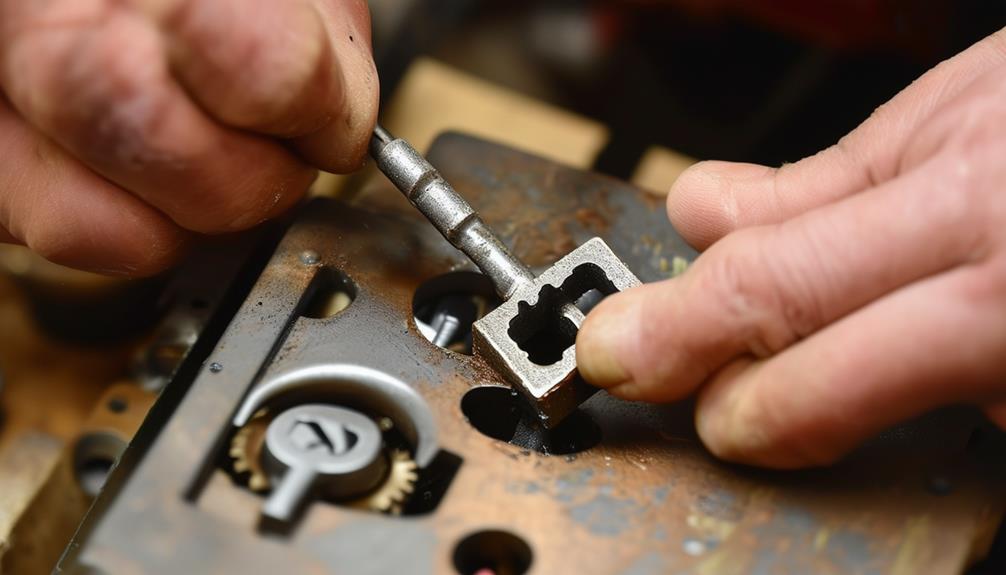
Considered one of the most subtle and effective techniques in lockpicking, impressioning methods involve creating a duplicate key by making an impression of the lock's pins and tumblers. This technique is particularly useful for locksmiths, as it allows them to replicate keys without damaging the lock, aligning with mastering advanced techniques.
To begin impressioning a lock, you'll need a blank key that fits the keyway. Using a file, you'll lightly shave down the key's surface. Insert the key into the lock and apply rotational pressure while gently moving it in and out. The pins and tumblers will leave marks on the key where they bind.
By repeating this process and gradually filing down the key where marks are left, you create a working key that matches the lock's internal mechanism. Impressioning requires patience and skill, but it's a non-destructive method that can provide a functional key without needing to disassemble the lock.
This technique is favored by locksmiths for its precision and ability to produce a working key efficiently.
Master Key System Exploitation

To investigate the domain of lockpicking further, let's now explore the intriguing concept of Master Key System Exploitation.
Master key system exploitation involves understanding how a master key operates within a system of locks and leveraging this knowledge for non-destructive entry. Here are some key points to evaluate:
- Understanding Master Key Systems: Master key systems are designed to allow multiple keys to open different locks within a system. Each lock has its unique key while the master key can open all locks. This is somewhat akin to the benefits and considerations of re-keying, where security and accessibility can be tailored to specific needs.
- Identifying Vulnerabilities: By identifying patterns or similarities in key cuts across locks, you may discover potential vulnerabilities in the system that can be exploited.
- Testing Key Combinations: Experimenting with key variations and testing different key combinations can help in finding a master key that works across multiple locks.
- Ethical Considerations: It's essential to approach master key system exploitation ethically and responsibly, ensuring that any techniques used are legal and authorized.
Master key system exploitation requires a deep understanding of lock mechanisms and key systems, making it a fascinating area for lockpicking enthusiasts to explore.
Tubular Lock Picking Techniques
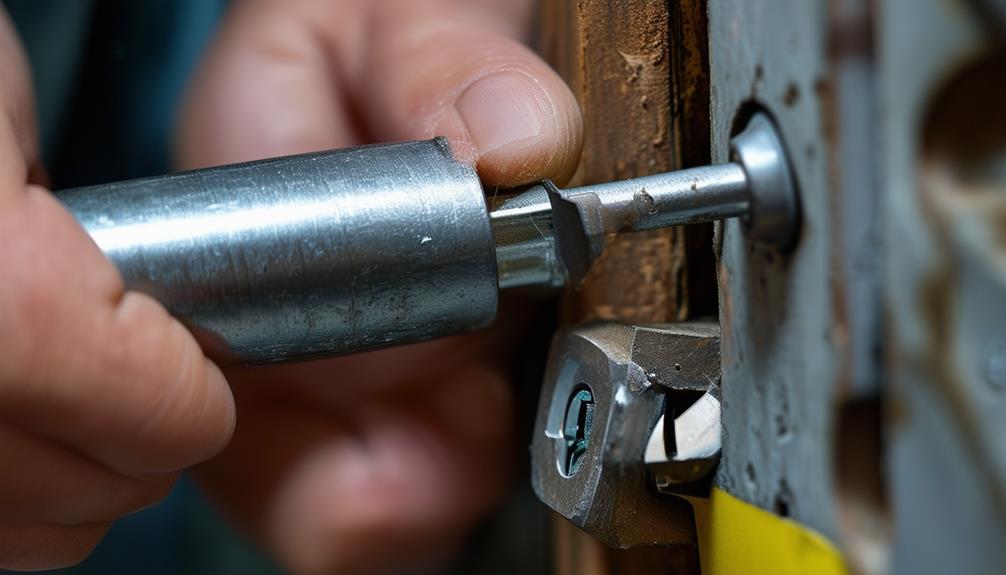
Exploring tubular lock picking techniques opens up a unique domain within the art of lockpicking. Tubular locks, also known as circle locks, are commonly found on vending machines, bike locks, and some electronic locks.
To effectively tackle these locks, it's important to understand the specialized tools available, such as the tubular lock pick, which is essential for success in this area. These picks have a ring of needles that correspond to the pins within the lock, making them critical for efficient lock picking, as noted in important tools that lock picking experts rely on.
To begin, insert the tubular lock pick into the keyway and apply gentle pressure. Rotate the pick in a clockwise or counterclockwise direction while simultaneously pushing the pins inward. As you manipulate the pins, you should feel them aligning with the shear line.
Once all the pins are aligned, the lock will turn, and the mechanism will disengage, allowing you to open the lock.
Mastering tubular lock picking techniques requires patience and practice. With dedication, you can develop the skills needed to access tubular locks efficiently and effectively.
Shimming Padlocks and Latches

Shimming padlocks and latches offers a versatile method for bypassing certain types of locks without causing damage. This technique involves using a thin piece of metal to manipulate the locking mechanism of the padlock or latch.
For beginners, it's crucial to have access to affordable lock picking tools that can make this process easier and more effective. Here are some key points to keep in mind when shimming padlocks:
- Material: Confirm you have a sturdy shim made of metal, such as a feeler gauge or a specially designed shim.
- Insertion: Slide the shim between the shackle and the locking mechanism, applying gentle pressure.
- Manipulation: Wiggle the shim up and down while gently turning the lock until you feel the shim slide into place.
- Unlocking: Once the shim is in the correct position, the locking mechanism should release, allowing you to open the padlock or latch effortlessly.
Using Bump Keys for Entry
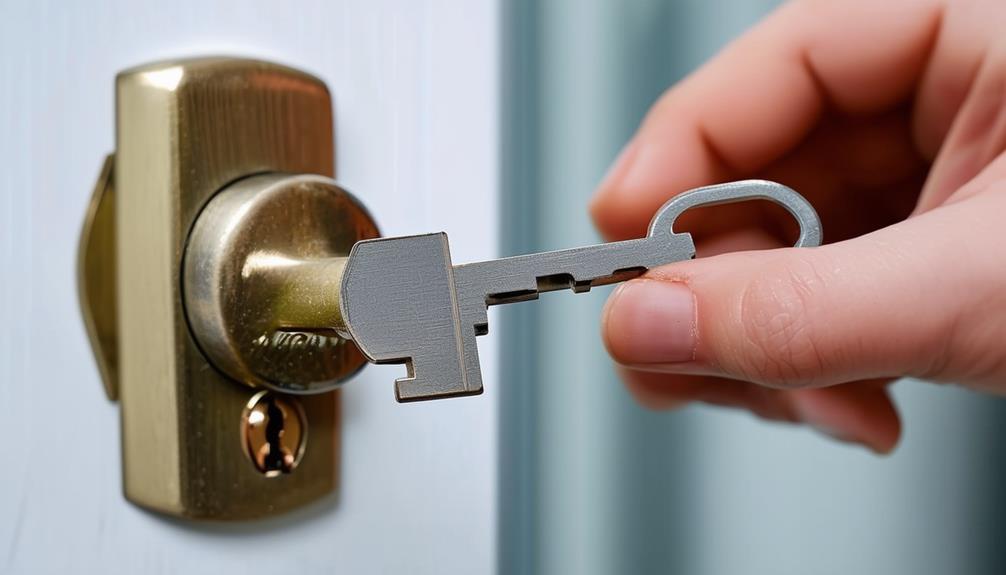
When it comes to bypassing certain locks without causing damage, another technique to contemplate is using bump keys for entry. Bump keys are specially crafted keys that manipulate the pins inside a lock to allow for quick and non-destructive entry.
These keys are particularly effective on basic pin tumbler locks, which are commonly found in residential doors. To use a bump key, insert it into the lock and apply slight pressure while simultaneously bumping the key with a hammer or similar tool. The force from the bump causes the pins to jump, allowing the key to turn and the lock to open.
Bump keys can be effective on pin tumbler locks, which are commonly found in residential doors. However, it's significant to highlight that bump keys may not work on all types of locks, especially high-security ones with additional features to prevent this method of entry.
While bump keys can be a handy tool for locksmiths and individuals in certain situations, it's vital to use them responsibly and ethically. Misusing bump keys to gain unauthorized access to properties is illegal and can result in serious consequences.
It's critical to always prioritize safety and security when considering using bump keys for entry.
Frequently Asked Questions
Can Non-Destructive Lock Picking Be Used Legally?
Yes, non-destructive lock picking can be used legally in certain situations.
Understanding local laws and regulations is essential when engaging in this practice. By ensuring that you have the proper authorization or consent to pick a lock, you can stay within the boundaries of the law.
Remember to always act responsibly and ethically when using non-destructive lock picking techniques.
Are There Any Risks of Damaging the Lock During Picking?
When picking locks, there's a chance of damaging the lock if not done carefully.
It's vital to use proper techniques and tools to minimize this risk. By being patient and precise, you can avoid causing harm to the lock while picking it.
How Long Does It Take to Learn Non-Destructive Lock Picking?
Learning non-destructive lock picking can vary based on your dedication and practice.
Typically, mastering the basics can take a few weeks to a few months. As you become more proficient, you'll find your speed and accuracy improving.
Is It Possible to Pick High-Security Locks Non-Destructively?
Yes, it's possible to pick high-security locks non-destructively.
It requires advanced skills and specialized tools, but with practice, you can master the techniques. Understanding the inner workings of these locks is essential for successful non-destructive picking.
By honing your abilities and gaining experience, you can effectively open high-security locks without causing any damage.
Can Non-Destructive Lock Picking Be Detected by Security Systems?
Can security systems detect non-destructive lock picking?
While some advanced systems may have sensors to detect tampering, not all can detect this method.
It's essential to research the security measures in place before attempting lock picking.
Remember, just because it's non-destructive doesn't mean it's undetectable.
Stay informed and cautious to avoid unwanted consequences.
Conclusion
You've now revealed the secrets to non-destructive lock picking, mastering techniques and tools that will open doors without leaving a trace. Like a silent shadow slipping through the night, you have the power to access locked spaces and hidden treasures. Embrace your newfound skills with caution and respect, for with great power comes great responsibility. Now go forth and unveil new possibilities with finesse and finesse.

